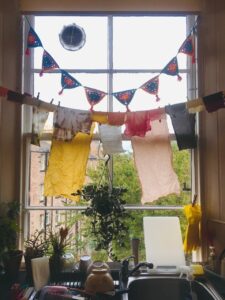This week, in my make-shift dye lab (aka the flat kitchen), I have spent hours stirring various concoctions; staring into the bubbling abyss, hearing distant chants “Double, double toil and trouble, Fire burn and cauldron bubble”.
THE PROCESS
I began by gathering leftover bits of fruits and vegetables to use for making the dyes, with the help from my lovely flatmates. We collected red onion skin, carrot peeling, avocado skin and pits, blueberries, beetroot, spinach and orange peels in various containers – as seen below.

To make saturated dyes, a Popsugar article recommends using at least one chopped cup of each item to create a saturated dye. Blueberries, blackberries, and red cabbage create lovely blues. Raspberries and beets create red shades. Orange and lemon peels make light yellow or ochre dye. Spinach creates a nice green, and onion skins simmer into orange.
https://www.popsugar.co.uk/smart-living/Homemade-Natural-Dyes-42747468?utm_medium=redirect&utm_campaign=US:GB&utm_source=direct

1. Add the chopped ingredient to a saucepan and cover with twice as much water as the fruit or vegetable. Place over medium heat and bring to a simmer for one hour.
2. Turn off the heat, and let water come to room temperature. Strain the cooled dyes into glass containers. I left my dyes overnight before using them the next day.
3. Wash fabrics before dying – I put mine in the washing machine for a short 30-minute cycle.
4. To create long-lasting coloured fabrics, place the article of clothing you’re planning on colouring in a fixative. For fruit dyes, simmer the fabric in 1/4 cup salt and 4 cups water. For vegetable dyes, simmer in one cup vinegar and four cups water. Boil for one hour.
5. Rinse the fixed fabric in cold water, and then let soak in the natural dye until it reaches desired colour – an hour or longer.
6. Wring fabric and rinse under cold water. Hang up to dry. Hand wash with fabric detergent. Once dry, iron to remove creases caused during dying/washing.


Furthermore, I experimented with tie-dying pieces of fabric. The results were…interesting. Some worked whilst others looked as if I had used them to wipe clean the bin on the street outside the flat. To be fair, I’m not sure what miracles I expected from tie-dying something using both onion and carrot peel dyes. So that pieces of literal trash did not go to waste, I proceeded to dye it using the strongest colour I had – blueberry with a hint of beetroot. A before and after can be seen below.

WHAT NEXT?
The plan now is to firstly select an album to use as the prototype and then draw embroidery designs, inspired by the track-listing, album title and lyrics of the songs. Exploring natural dyes has been an interesting and exciting process – taking food waste that otherwise would be thrown in the bin and forgotten about into colourful pieces of fabric. However, the moment of truth when you lift the fabric from the dye bath and rinse it will always simultaneously fill me with joy and fear. Watching the dye run almost completely out of a piece of fabric, that you lovingly tended to for hours, must be classed as a form of heartbreak.

Side note:
I would just like to formally apologise to my flatmates, for the awful smells created by boiling spinach, onion peel, carrots, beetroot, orange peel, blueberries, avocado and vinegar for hours on end. It smelt just as bad as you might imagine – eau de poubelle.




Really enjoy reading your post Hope. Like your humour and style of writing . I hope you are documenting all your dye recipes as this is a good investigation into food dying and maybe of use later on.
Looking forward to seeing and reading your next post .
Shirley